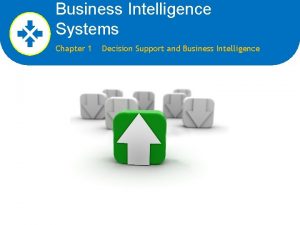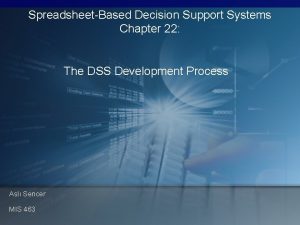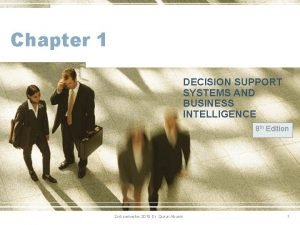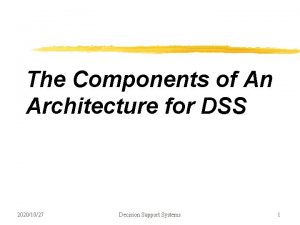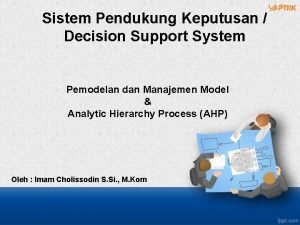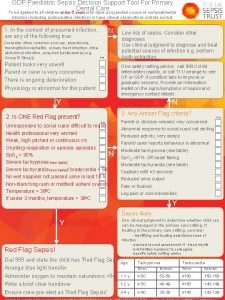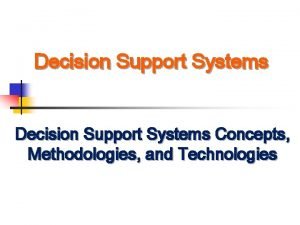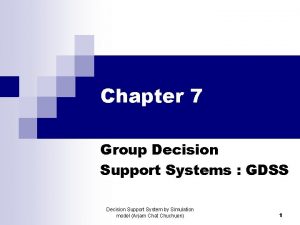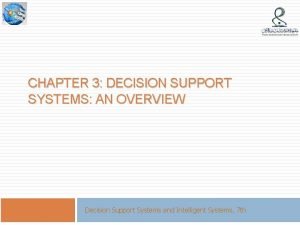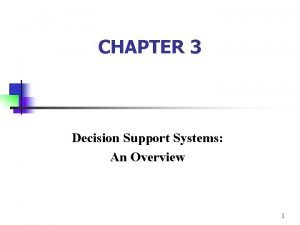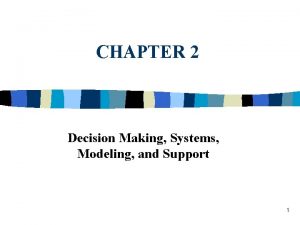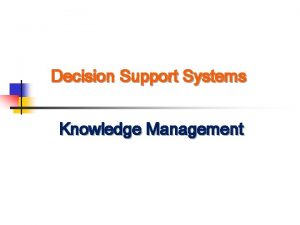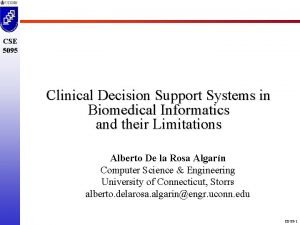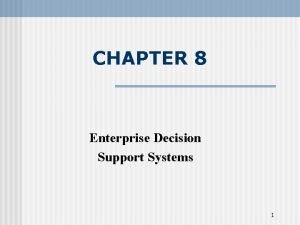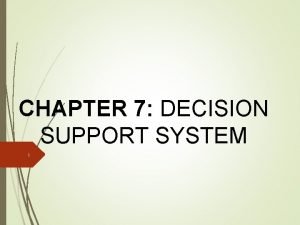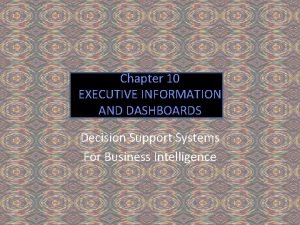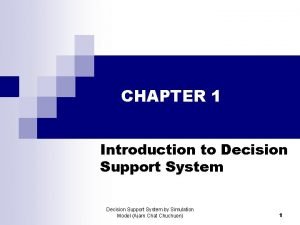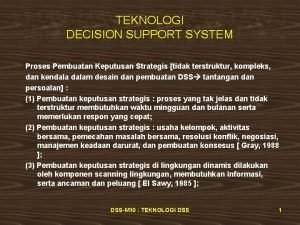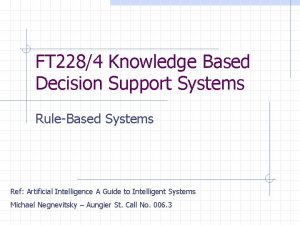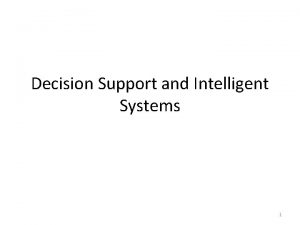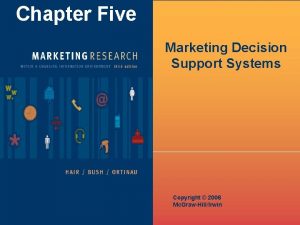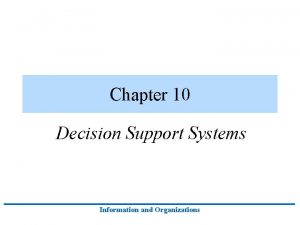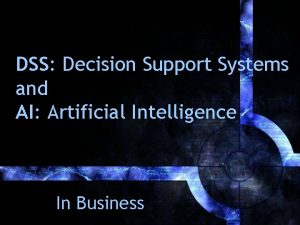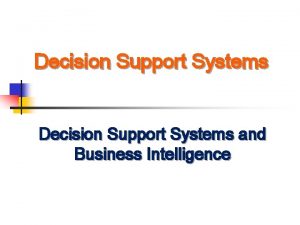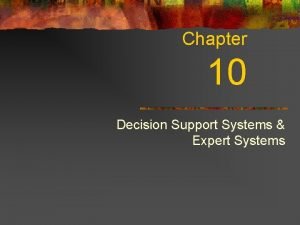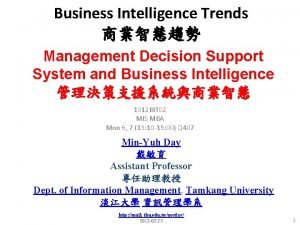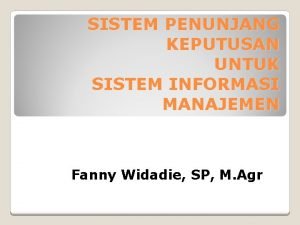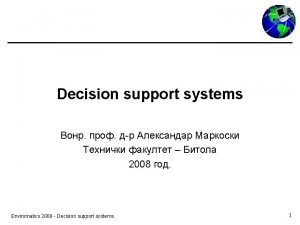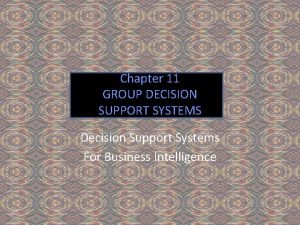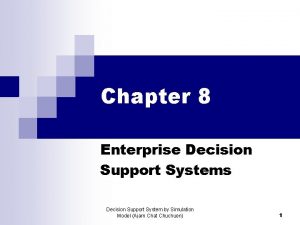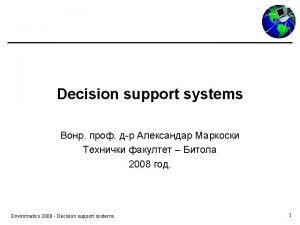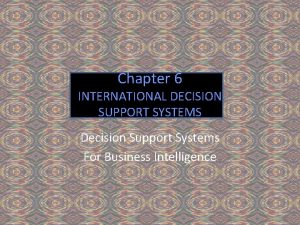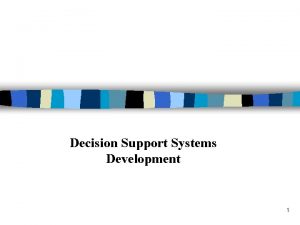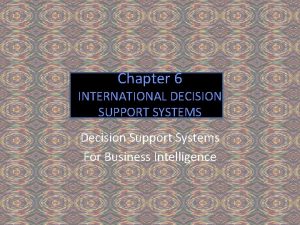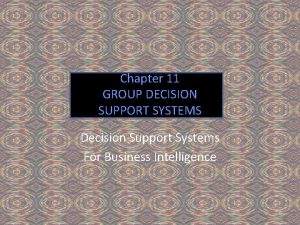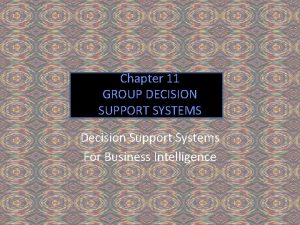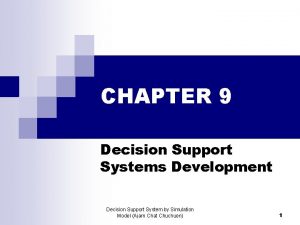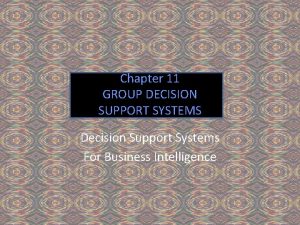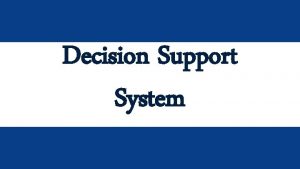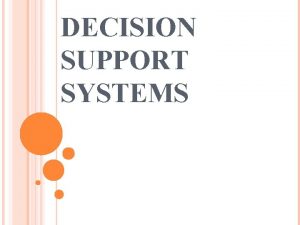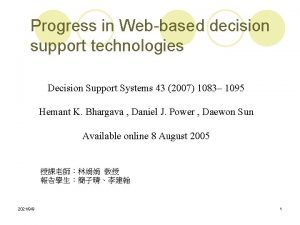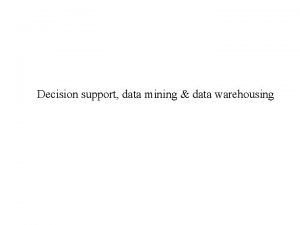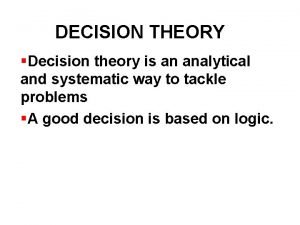Welcome to CPIS320 Decision Support Systems Theory Instructor









































- Slides: 41

Welcome to CPIS-320 Decision Support Systems - Theory Instructor : Dr. Nahla Aljojo Email: Nahla_aljojo@yahoo. com

Chapter 1 Decision Support Systems and Business Intelligence

Changing Business Environment n n Companies are moving aggressively to computerized support of their operations => Business Intelligence (BI) Business Pressures–Responses–Support Model n Business pressures: the actions done in the business environment, which require us to take some actions are called business pressures. There are result of today's competitive business climate n Responses to counter the pressures n Support to better facilitate the process

Business Pressures–Responses–Support Model

The Business Environment n The environment in which organizations operate today is becoming more and more complex, creating: n Opportunities, and n problems/threat n Example: globalization: Today, you can easily find suppliers and customers in many countries which mean you can buy cheaper materials and sell more of your products and services: great opportunities exist. However, globalization also means more and stronger competitors

Main Factors Affecting a Business Environment FACTOR DESCRIPTION Markets Strong competition Expanding global markets Blooming electronic markets on the Internet Innovative marketing methods Opportunities for outsourcing with IT support Need for real-time, on-demand transactions Consumer Desire for customization demand Desire for quality, diversity of products, and speed of delivery Customers getting powerful and less loyal Technology More innovations, new products, and new services Increasing obsolescence rate Increasing information overload Social networking, Web 2. 0 and beyond Societal Growing government regulations and deregulation Workforce more diversified, older, and composed of more women Prime concerns of homeland security and terrorist attacks Necessity of Sarbanes-Oxley Act and other reporting-related legislation Increasing social responsibility of companies Greater emphasis on sustainability

Main Objective of DSS: Closing the Strategy Gap n One of the major objectives of computerized decision support is to facilitate closing the gap between the current performance of an organization and its desired performance, as expressed in its mission, objectives, and goals, and the strategy to achieve them.

Review questions 1. List the components of and explain the Business Pressures–Responses–Support Model 2. What are some of the major factors in today`s business environment? 3. What are some of the major Response activities that organizations take?

Managerial Decision Making n Management is a process by which organizational goals are achieved by using resources n Inputs: resources n Output: attainment of goals n n Management Decision Making n n n The degree of success of the organization and the manager is often measured by the ratio of outputs to inputs. : outputs / inputs Management Functions: Planning, organizing, leading and controlling Many managerial activities in all roles revolve around decision making. Managers especially those at high level are primarily decision makers. Decision making: selecting the best solution from two or more alternatives

Managerial Decision Making n n Many managerial activities in all roles revolve around decision making. Managers especially those at high level are primarily decision makers. For years, managers considered decision making an art. (What is the difference between science and art? ) This art was purely based on creativity, judgment, intuition and experience, rather than on systematic quantitative method – that is science. However, systematic, methodical thoughtful, analytic decision making outperforms the flashiness of interpersonal skills.

Managerial Decision Making Simple Decision Making Process n Managers usually make decisions by following a fourstep process (a. k. a. the scientific approach) 1. Realize and define the problem (or opportunity) 2. Construct a model that describes the real-world problem q Understand the components of the problem and the related environment 3. Identify possible solutions to the modeled problem and evaluate the solutions 4. Compare, choose, and recommend a potential solution to the problem

Managerial Decision Making Decision making is difficult, because n n Technology, information systems, advanced search engines, and globalization result in more and more alternatives from which to choose Government regulations and the need for compliance, political instability, competition, and changing consumer demands produce more uncertainty, making it more difficult to predict consequences and the future Some factors require to make rapid decisions, the frequent and unpredictable changes that make trial-and-error learning difficult, and the potential costs of making mistakes The business environment is getting more and more complex.

How to solve this difficulty? n n n Computerized DSS can facilitate decision making From automated factories to Artificial intelligence (AI) methods to the evaluation of proposed mergers and acquisitions. BI tools such as n Data warehousing, data mining, online analytical processing(OLAP), dashboards are corners of today’s management

Review Questions 1. Why have some argued that management is the same as decision making? 2. Describe the four steps managers take in making a decision? 3. Why the Decision making is difficult? 4. What is the difference between science or art? 5. Is decision making science or art?

Computerized Support for DM Why Use Computerized DSS? n Computerized DSS can facilitate decision via: n Speedy computations n Improved communication and collaboration n Increased productivity of group members n Improved data management n Overcoming cognitive limits n Quality support; agility support n Using Web; anywhere, anytime support

Computerized Decision Making Managerial decision making Computerized support Computerized decision making

Systematic Decision-Making Process

Decision-Making Process Intelligence. This phase involves searching for condition; that call for decisions. Design. This phase involves Inventing, developing, and analyzing possible alternative courses of action (solutions). Choice. This phase involves selecting 3 course of action from among those available. Implementation". This phase involves adapting the selected course of action to the decision situation (i. e. , problem solving of opportunity exploiting).

A Decision Support Framework (by Gory and Scott-Morten, 1971)

A Decision Support Framework – cont. n Types of Control n Strategic planning (top-level, long-range) n Management control (middle-level tactical planning) n Operational control (low-level) Strategic planning Management control Operational control Green area represents the volume of the decision making

Types of Control Strategic planning, which involves defining long range goals and policies for resource allocation Management control, the acquisition and efficient use of resources in the accomplishment of organizational goals Operational control, the efficient and effective execution of specific tasks

Types of Decisions n Degree of Structuredness (Simon, 1977) n n Decision are classified as n Highly structured (a. k. a. programmed) n Semi-structured n Highly unstructured (i. e. , non-programmed) Structured decisions may be programmed directly; semi-structured and unstructured may not be programmed. There can be a supportive system for them called DSS.

Computer Support for Structured Decisions n Structured decisions are for structured problems n Properties of structured problems n n Problem for which the existing state and desired state are clearly identified, and the methods to reach the desired state are fairly obvious. structured problems can usually be broken down into a series of welldefined steps Structured problems are encountered repeatedly, have a high level of structure It is possible to abstract, analyze, and classify them into specific categories n n e. g. , make-or-buy decisions, capital budgeting, resource allocation, distribution, procurement, and inventory control For each category a solution approach is developed, generally a quantitative formula => Management Science (MS)

n Example from daily life n n Food preparation at Al-Baik etc. is a structured problem Food preparation at home is unstructured problem (USUALLY) n n n Why? Can make it structure if you follow the same steps, time, and amount of ingredients Can you give some examples from your daily life?

Computer Support for Structured Decisions Management Science Approach n n Also referred to as Operation Research In solving problems, managers should follow the fivestep MS approach 1. Define the problem / opportunity 2. Classify the problem into a standard category (*) 3. Construct a model that describes the real-world problem 4. Identify possible solutions to the modeled problem and evaluate the solutions 5. Compare, choose, and recommend a potential solution to the problem

Computer Support for Structured Decisions Management Science Approach cont. n Management Science is based on mathematical modeling (i. e. algebraic expressions that describe problems). n Modeling involves transforming a real-world problem into an appropriate prototype structure (model).

Computer Support for Structured Decisions Automated Decision Making n A relatively new approach to supporting decision making n Applies to highly structured decisions n n Automated decision systems (ADS) (or decision automation systems) An ADS is a rule-based system that provides a solution to a repetitive managerial problem in a specific area n e. g. , simple-loan approval system n Determine the price of a product (e. g. airline ticket)

Computer Support for Structured Decisions Automated Decision Making n ADS initially appeared in the airline industry called revenue (or yield) management (or revenue optimization) systems n n n dynamically price tickets based on actual demand Today, many service industries use similar pricing models ADS are driven by business rules!

Computer Support for Structured Decisions Automated Decision-Making Framework

Application case n Giant Food Stores Prices the entire store automatically

Unstructured Decisions n n Situation in which its existing state and the desired state are UNCLEAR and, hence, methods of reaching the desired state CANNOT be found. Properties of unstructured problems n have unclear goals and incomplete information n require the use of intuition, judgment, reasoning, and memory. n require customized solutions n They are complex and ill-defined. n They have many possible answers. n They do not have one best answer. n n Unstructured problems can be only partially supported by standard computerized quantitative methods They benefit from data and information

Unstructured Decisions n n Here is an example of an unstructured problem: The population of your community is growing. Your water supply will not support many new people. What do you do? This is a complex problem. It affects the people, the environment, and the quality of life itself. To arrive at a good solution, you would need to use math, science, political science and psychology, and probably more! This problem actually occurs frequently in areas with a growing population. In one community facing this problem, 14 possible solutions were presented to the public. A solution was then chosen that the majority of the public agreed upon. It wasn't the "best" solution because all of the 14 possible solutions had strengths and weaknesses. The lesson here is that unstructured problems usually have several workable solutions. Each solution has advantages and disadvantages that depend on who is affected by the solution.

Computer Support for Semi-structured Problems n n n Solving semi-structured problems may involve a combination of standard solution procedures and human judgment MS handles the structured parts while DSS deals with the unstructured parts With proper data and information, a range of alternative solutions, along with their potential impacts

Review Questions 1. What are structured, Unstructured, and semistructured decisions? Provide two examples of each. 2. Define operational control, managerial control, and strategic planning? Provide two examples of each. 3. What are the nine cells of the decision framework? Explain what each is for. 4. How can computers provide support for making structured decisions? 5. Define automated decision systems (ADS)? 6. How can computers provide support to semistructured and unstructured decisions?

High-Level Architecture of a DSS Components of the DSS Architecture 1) Data, 2) Model, 3) Knowledge/Intelligence 4) User, Interface (API and/or user interface)

Business Intelligence (BI) n n BI is an umbrella term that combines architectures, tools, databases, analytical tools, applications, and methodologies Like DSS, BI a content-free expression, so it means different things to different people BI's major objective is to enable easy access to data (and models) to provide business managers with the ability to conduct analysis BI helps transform data, to information (and knowledge), to decisions and finally to action

The Evolution of BI Capabilities

A High-Level Architecture of BI

Components in a BI Architecture n n The data warehouse is a large repository of well-organized historical data Business analytics are the tools that allow transformation of data into information and knowledge Business performance management (BPM) allows monitoring, measuring, and comparing key performance indicators User interface (e. g. , dashboards) allows access and easy manipulation of other BI components

The Benefits of BI n n The ability to provide accurate information when needed, including a real-time view of the corporate performance and its parts A survey by Thompson (2004) n Faster, more accurate reporting (81%) n Improved decision making (78%) n Improved customer service (56%) n Increased revenue (49%)

Review Questions 1. Describe the Architecture of DSS? 2. Define BI? 3. List and describe the major components of BI? 4. What are the major similarities and differences of DSS and BI?
 Decision support systems and intelligent systems
Decision support systems and intelligent systems No decision snap decision responsible decision
No decision snap decision responsible decision Financial management process
Financial management process Decision support and business intelligence systems
Decision support and business intelligence systems Developing spreadsheet-based decision support systems
Developing spreadsheet-based decision support systems What is decision support system in business intelligence
What is decision support system in business intelligence Decision support and expert systems
Decision support and expert systems Engineering elegant systems: theory of systems engineering
Engineering elegant systems: theory of systems engineering Engineering elegant systems: theory of systems engineering
Engineering elegant systems: theory of systems engineering Wise men three clever are we
Wise men three clever are we Decision table and decision tree examples
Decision table and decision tree examples Types of tps
Types of tps Components of decision support system
Components of decision support system Contoh decision support system adalah
Contoh decision support system adalah Navify decision support
Navify decision support Gdp sepsis decision support tool
Gdp sepsis decision support tool Components of decision support system
Components of decision support system Components of group decision support system
Components of group decision support system Group decision support and groupware technologies
Group decision support and groupware technologies Characteristics of a decision support system
Characteristics of a decision support system Components of decision support system
Components of decision support system Systematic decision making process
Systematic decision making process Model driven decision support system
Model driven decision support system Knowledge management decision support
Knowledge management decision support Iliad clinical decision support system
Iliad clinical decision support system Purpose of enterprise decision support system
Purpose of enterprise decision support system Objectives of decision support system
Objectives of decision support system Decision support system dashboards
Decision support system dashboards Decision chapter 1
Decision chapter 1 Proses decision support system
Proses decision support system Knowledge based decision support system
Knowledge based decision support system Benefits of decision support system
Benefits of decision support system The marketing decision support system mdss
The marketing decision support system mdss Disadvantages of decision support system
Disadvantages of decision support system Voyage estimating decision support system
Voyage estimating decision support system Difference between dss and expert system
Difference between dss and expert system Dss business intelligence
Dss business intelligence Operational data vs decision support data
Operational data vs decision support data Decision categories
Decision categories Business intelligence framework
Business intelligence framework Voyage estimating decision support system
Voyage estimating decision support system Maintenance decision support system
Maintenance decision support system



